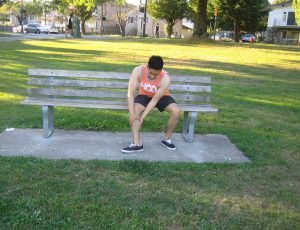Having swollen feet and ankles is called edema. Edema involves swelling due to the presence of excess fluids trapped in the tissues of the body. It can be caused by pregnancy, medications and underlying diseases such as kidney disease, heart failure and cirrhosis of the liver.
[youtube url=”https://www.youtube.com/watch?v=_F83oWOcD48″ width=”220″]Symptoms of edema
- The skin becomes stretched and shiny
- Swelling or puffiness of the tissue can be seen under the skin
- The skin leaves a dimple behind after pressed for a few seconds
- Increased abdominal size
When there is shortness of breath, pain in the chest and difficulty breathing, it is vital to seek medical help immediately.
Causes
- Eating excessively salty foods
- Sitting or staying in one position for long periods of time
- Premenstrual signs and symptoms
Swelling or puffiness of the tissue can be seen under the skin - Pregnancy
- Side effects of some medications such as non-steroidal anti-inflammatory drugs (NSAIDs), medications for high blood pressure, estrogens and medications for diabetes
Treatment
- Perform exercises and yoga to increase circulation of blood in the area. Seek the help of the physical therapist for some guided exercises suited for the condition.
- Elevate the affected area of the body above the level of the heart several times every day to lessen the swelling. The affected area can also be elevated while sleeping.
- Massage the area using firm and gentle pressure to eliminate the excess fluid out of the affected area.
- Wear a support hose or compression gear to prevent swelling of the feet. Wear compression socks that are knee or thigh high or full compression stockings.
- Keep the affected area clean, moisturized and not injured. Skin that is dry and cracked is susceptible to cuts, scrapes and infection.
- Minimize the consumption of salt to prevent accumulation of fluid that can make the edema worse.
Additional measures
- Use the contrast hydrotherapy treatment which uses both cold and warm water. Fill 2 foot tubs where one is filled with cold water and the other is filled with warm water. Soak the feet in warm water for at least 3-4 minutes, after that immediately put the feet in the cold water for at least 1 minute. Continue alternating for 15-20 minutes several times every day until there is relief. Warm water increases the blood circulation while cold water lessens the swelling and inflammation.
- Drink at least 8-10 glasses of water to flush out toxins in the body. Another way is adding cucumber and lemon slices to the water. Cucumber and lemon possesses anti-inflammatory properties that lessens the swelling.
- Soak the swollen area in tonic water. The quinine and the bubbles in the tonic water lessens the inflammation and swelling.
- Another way of treating edema is soaking the affected area in salt water. In a bucket filled with water, add some Epsom salt and mix them well and then soak the feet in the solution. This method works by relaxing the muscles and lessens the swelling.
FACT CHECK
https://www.emedicinehealth.com/edema/article_em.htm
https://www.webmd.com/heart-disease/heart-failure/edema-overview#1
https://www.mayoclinic.org/diseases-conditions/edema/symptoms-causes/syc-20366493


